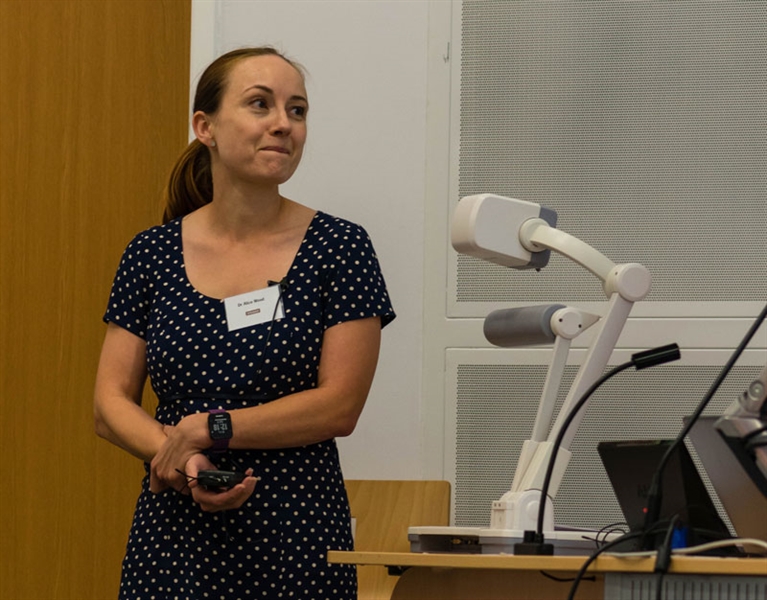The UK SCAD research project is currently focusing on a detailed sub-study looking at men with SCAD, and people with recurrent SCAD. Dr Alice Wood, Research Fellow (pictured), started recruiting patients in September 2018.
Why men?
Dr Alice Wood said: “I chose to study men with SCAD because this is a group that really hasn’t been looked at in the past. Decades ago, SCAD was thought to be a condition that only affected women, primarily in pregnancy. We therefore hope to clarify why SCAD happens in men who of course are not exposed to the hormonal fluctuations of the menstrual cycle, pregnancy, and the menopause. In addition, it is clear that hormonal changes are not the only risk factors for SCAD in women, and we hope that studying men will provide some insight into other factors, which will also be informative for our female patients.”
Why recurrent SCADs?
There were two reasons for looking at patients who have had more than one SCAD. “Firstly, we wonder whether these are people with a more marked tendency to SCAD, meaning that with small sample numbers we will be more likely to identify differences and thus find out more about why SCAD happens,” explained Dr Wood.
“Secondly, it is clearly very important to patients to understand recurrence risk, and so if we can identify particular factors that predispose to recurrence, this will be of great clinical value.”
What does the study involve?
Dr Wood has recruited both SCAD patients and healthy volunteers, who act as ‘controls’. She is doing a number of tests in both groups. These are:
Brachial artery flow mediated dilatation – this is a test that looks at the reactivity of the artery in the arm. “The reason for doing this test is that we wonder whether the coronary arteries in SCAD may be more reactive, more prone to spasm or constriction for example, and whether this might be something that we can demonstrate in the arm arteries,” said Dr Wood.
Exercise testing – the study is are looking at this for a number of reasons. “On pragmatic clinical grounds, many of our patients are keen to get back to sport and we want to confirm our belief that this is safe, and that SCAD patients do not have particular issues with exercise,” Dr Wood explained.
“We know that a small proportion of SCAD patients suffer their event during or after exercise, and we want to look at whether there may be reasons for this such as a more dramatic blood pressure response to exercise in these patients,” she added.
“We are also interested in studying the autonomic (involuntary) nervous system, which controls many aspects of bodily function including responses to stress, and one way of studying this is by looking at heart rate recovery, the rate at which the heart rate returns to baseline after its rise with exercise.”
Cardiac MRI with pharmacological and psychological stress – cardiac MRI shows a number of things. It allows the researchers to look at the cardiac structure and function, and the size of any scar after SCAD. In this particular study Dr Wood is also looking at responses to pharmacological stress, to see whether there is any difference in perfusion (the passage of fluid through the circulatory system) in patients with SCAD.
Dr Wood said “We know there is not likely to be a difference in perfusion in the major arteries as most patients with SCAD have angiographically normal coronary arteries if they have further imaging, however it is possible that there are differences in the microvessels (too small to see on angiography) which may explain phenomena such as post SCAD chest pain.”
She added: “I am also looking at psychological stress as we know that a proportion of SCAD cases happen after psychological stress, and that some SCAD survivors have chest pain when under emotional stress. I am interested to see both whether SCAD survivors have more marked responses to psychological stress (in terms of blood pressure and heart rate) and also whether this affects myocardial perfusion.”
24-hour ECG – this is to look at heart rate variability which is a marker of autonomic (involuntary) function. As above the researchers are interested in autonomic function because it controls things like blood pressure and heart rate response to stress, which may be different in SCAD patients.
Dr Wood’s plan is to study 30 male patients and 30 female recurrence patients, with 30 matched controls for each group. So far she has recruited all 30 male SCAD survivors, 18 male healthy controls, 17 women with recurrent SCAD, and 10 female healthy controls. There are also a good number of participants booked in for visits over the next few weeks.
Dr Wood added “I am very grateful to Beat SCAD for their support (financial and otherwise) for this work.”
Dr Wood’s work is part-funded by generous donations and fundraising by Beat SCAD supporters.

